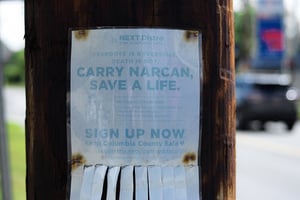Deaths From Illicit Opioids Rise Dramatically While Deaths From Prescription Opioids Fall
 |
The report also showed a 37.1% decrease in opioid prescribing; wider use of state Prescription Drug Monitoring Programs; and increasing numbers of doctors trained to prescribe buprenorphine (a medication used for treating opioid use disorder).
The trends indicate that the nature of the nation’s drug overdose crisis has changed. “The nation’s drug overdose epidemic is now being driven predominantly by highly potent illicit fentanyl, heroin, methamphetamine, and cocaine, although mortality involving prescription opioids remains a top concern,” Patrice A. Harris, M.D., M.A., chair of the AMA Opioid Task Force, said in a press release. Harris is a psychiatrist and immediate past president of the AMA.
Harris emphasized the importance of naloxone, a drug that can be used to reverse an opioid overdose in an emergency. “If it weren’t for naloxone, there likely would be tens of thousands additional deaths,” she said.
Drawing on statistics from the Centers for Disease Control and Prevention, the AMA reported that from 2015 to 2019, deaths involving illicitly manufactured fentanyl and fentanyl analogs increased from 5,766 to 36,509; deaths involving stimulants increased from 4,402 to 16,279; deaths involving cocaine increased from 5,496 to 15,974; and deaths involving heroin increased from 10,788 to 14,079.
In contrast, deaths involving prescription opioids decreased from 12,269 to 11,904.
The AMA report encouraged policymakers to take the following actions to remove barriers to evidence-based care for patients with pain and those with substance use disorder:
- Remove prior authorization, step therapy, and other inappropriate administrative burdens or barriers that delay or deny care for FDA-approved medications used as part of medication-assisted treatment (MAT) for opioid use disorder.
- Enforce meaningful oversight and enforcement of state and federal mental and substance use disorder parity laws, including requiring health insurance companies to demonstrate compliance with parity laws.
- Support efforts to expand sterile needle and syringe services programs.
- Support reforms in the civil and criminal justice system that ensure access to high-quality, evidence-based care for opioid use disorder, including MAT.
“We know that ending the drug overdose epidemic will not be easy, but if policymakers allow the status quo to continue, it will be impossible,” Harris said. “This is particularly important given concerns that the COVID-19 pandemic is worsening the drug overdose epidemic. Physicians will continue to do our part. We urge policymakers to do theirs.”
For related information, see the American Journal of Psychiatry article “New Challenges in Addiction Medicine: COVID-19 Infection in Patients With Alcohol and Substance Use Disorders—The Perfect Storm.”
(Image: iStock/smartstock)





